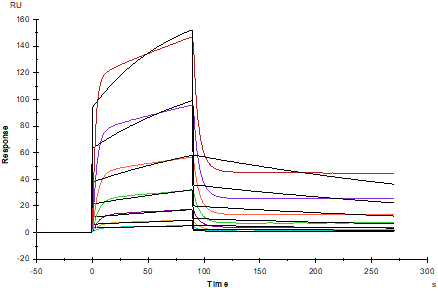Val19-Leu543, with C-terminal 10*His VEETLMDSTTATAELGWMVHPPSGWEEVSGYDENMNTIRTYQVCNVFESSQNNWLRTKFIRRRGAHRIHVEMKFSVRDCSSIPSVPGSCKETFNLYYYEADFDSATKTFPNWMENPWVKVDTIAADESFSQVDLGGRVMKINTEVRSFGPVSRSGFYLAFQDYGGCMSLIAVRVFYRKCPRIIQNGAIFQETLSGAESTSLVAARGSCIANAEEVDVPIKLYCNGDGEWLVPIGRCMCKAGFEAVENGTVCRGCPSGTFKANQGDEACTHCPINSRTTSEGATNCVCRNGYYRADLDPLDMPCTTIPSAPQAVISSVNETSLMLEWTPPRDSGGREDLVYNIICKSCGSGRGACTRCGDNVQYAPRQLGLTEPRIYISDLLAHTQYTFEIQAVNGVTDQSPFSPQFASVNITTNQAAPSAVSIMHQVSRTVDSITLSWSQPDQPNGVILDYELQYYEKELSEYNATAIKSPTNTVTVQGLKAGAIYVFQVRARTVAGYGRYSGKMYFQTMTEAEYQTSIQEKLPLGGGSGGGSHHHHHHHHHH
1. Nonsense-mediated decay microarray analysis identifies mutations of EPHB2 in human prostate cancer. Huusko P., Ponciano-Jackson D., Wolf M., Kiefer J.A., Azorsa D.O., Tuzmen S., Weaver D., Robbins C., Moses T., Mousses S. 2. A mutation of the human EPHB2 gene leads to a major platelet functional defect. Berrou E., Soukaseum C., Favier R., Adam F., Elaib Z., Kauskot A., Bordet J.C., Ballerini P., Loyau S., Bryckaert M.
Receptor tyrosine kinase which binds promiscuously transmembrane ephrin-B family ligands residing on adjacent cells, leading to contact-dependent bidirectional signaling into neighboring cells. The signaling pathway downstream of the receptor is referred to as forward signaling while the signaling pathway downstream of the ephrin ligand is referred to as reverse signaling. Functions in axon guidance during development. Involved in the guidance of commissural axons, that form a major interhemispheric connection between the 2 temporal lobes of the cerebral cortex. Also involved in guidance of contralateral inner ear efferent growth cones at the midline and of retinal ganglion cell axons to the optic disk. In addition to axon guidance, also regulates dendritic spines development and maturation and stimulates the formation of excitatory synapses. Upon activation by EFNB1, abolishes the ARHGEF15-mediated negative regulation on excitatory synapse formation. Controls other aspects of development including angiogenesis, palate development and in inner ear development through regulation of endolymph production. Forward and reverse signaling through the EFNB2/EPHB2 complex regulate movement and adhesion of cells that tubularize the urethra and septate the cloaca. May function as a tumor suppressor. May be involved in the regulation of platelet activation and blood coagulation.

2μg (R: reducing
condition, N: non-reducing condition).

Immobilized EphB2 His Tag, Human (Cat. No. UA010599) at 2.0μg/mL (100μL/well) can bind Ephrin-B2 Fc Chimera, Human (Cat. No. UA010160) with EC50 of 0.48-0.90ng/ml.

Protein A Chip captured Ephrin-B2 Fc Chimera, Human (Cat. No. UA010160), can bind EphB2 His Tag, Human (Cat. No. UA010599) with an affinity constant of 23.71nM as determined in SPR assay.